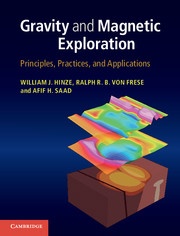Book contents
- Frontmatter
- Dedication
- Contents
- Preface
- Acknowledgements
- 1 Introduction
- Part I Gravity exploration
- Part II Magnetic exploration
- 8 The magnetic method
- 9 Magnetic potential theory
- 10 Magnetization of Earth materials
- 11 Magnetic data acquisition
- 12 Magnetic data processing
- 13 Magnetic anomaly interpretation
- Part III Applications
- Appendix A Data systems processing
- References
- Index
12 - Magnetic data processing
from Part II - Magnetic exploration
Published online by Cambridge University Press: 05 May 2013
- Frontmatter
- Dedication
- Contents
- Preface
- Acknowledgements
- 1 Introduction
- Part I Gravity exploration
- Part II Magnetic exploration
- 8 The magnetic method
- 9 Magnetic potential theory
- 10 Magnetization of Earth materials
- 11 Magnetic data acquisition
- 12 Magnetic data processing
- 13 Magnetic anomaly interpretation
- Part III Applications
- Appendix A Data systems processing
- References
- Index
Summary
Overview
As in the gravity method, magnetic measurements include effects from a wide variety of sources – from terrain, natural and man-made surface features, as well as instrumental, geological, and planetary sources. These sources have a range of amplitudes and periods in the case of temporal variations and wavelengths in spatial contributors which can mask or at least distort magnetic effects from subsurface sources of interest in a survey. Accordingly, observed data are processed to eliminate or at least minimize these effects. The product of this processing is the magnetic anomaly. Fortunately, in most magnetic survey campaigns these extraneous variations are considerably less effective in distorting effects of subsurface sources than those of the gravity method. Thus, the requirements for auxiliary data and reduction procedures are much less stringent for the magnetic method than in the gravity method. The corrections for these effects are largely obtained empirically from measurements of changes in temporal and spatial characteristics of magnetic fields.
Spatial extraneous variations directly perturb the distribution of subsurface effects over the Earth's surface, while extraneous temporal variations cause errors in the measurements. Processing in magnetic exploration removes the extraneous variations directly from the observations, rather than modeling the field at the observation site as in gravity data processing. However, the result is the same. It is equivalent to the anomaly obtained by subtracting the theoretical field from the observations. Magnetic anomalies for interpretational purposes are commonly transformed into the equivalent anomaly that would be observed at the geomagnetic pole. This reduction-to-the pole shifts the anomaly to a position directly over the source and increases the anomaly's symmetry, simplifying the magnetic interpretation.
- Type
- Chapter
- Information
- Gravity and Magnetic ExplorationPrinciples, Practices, and Applications, pp. 300 - 337Publisher: Cambridge University PressPrint publication year: 2013



